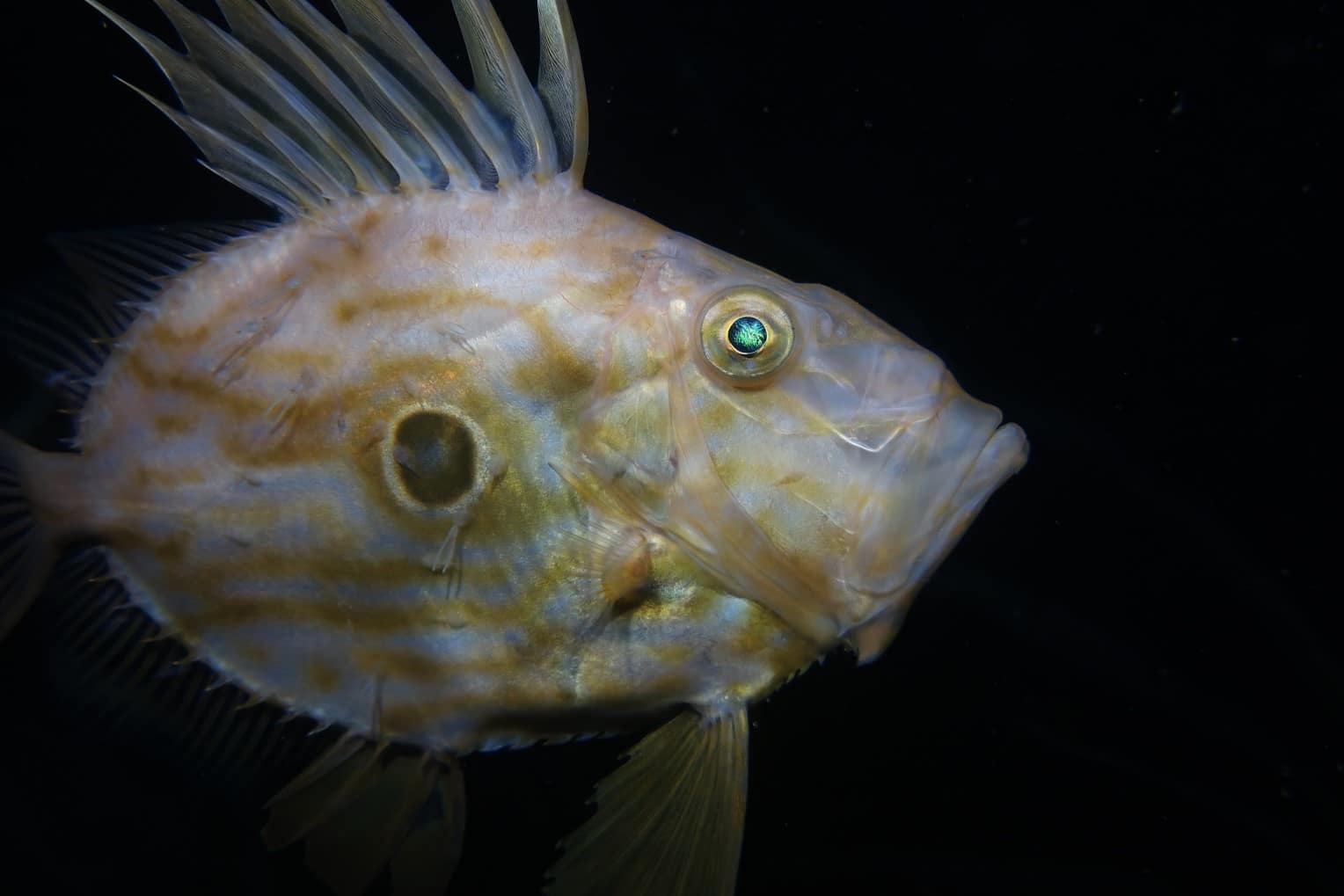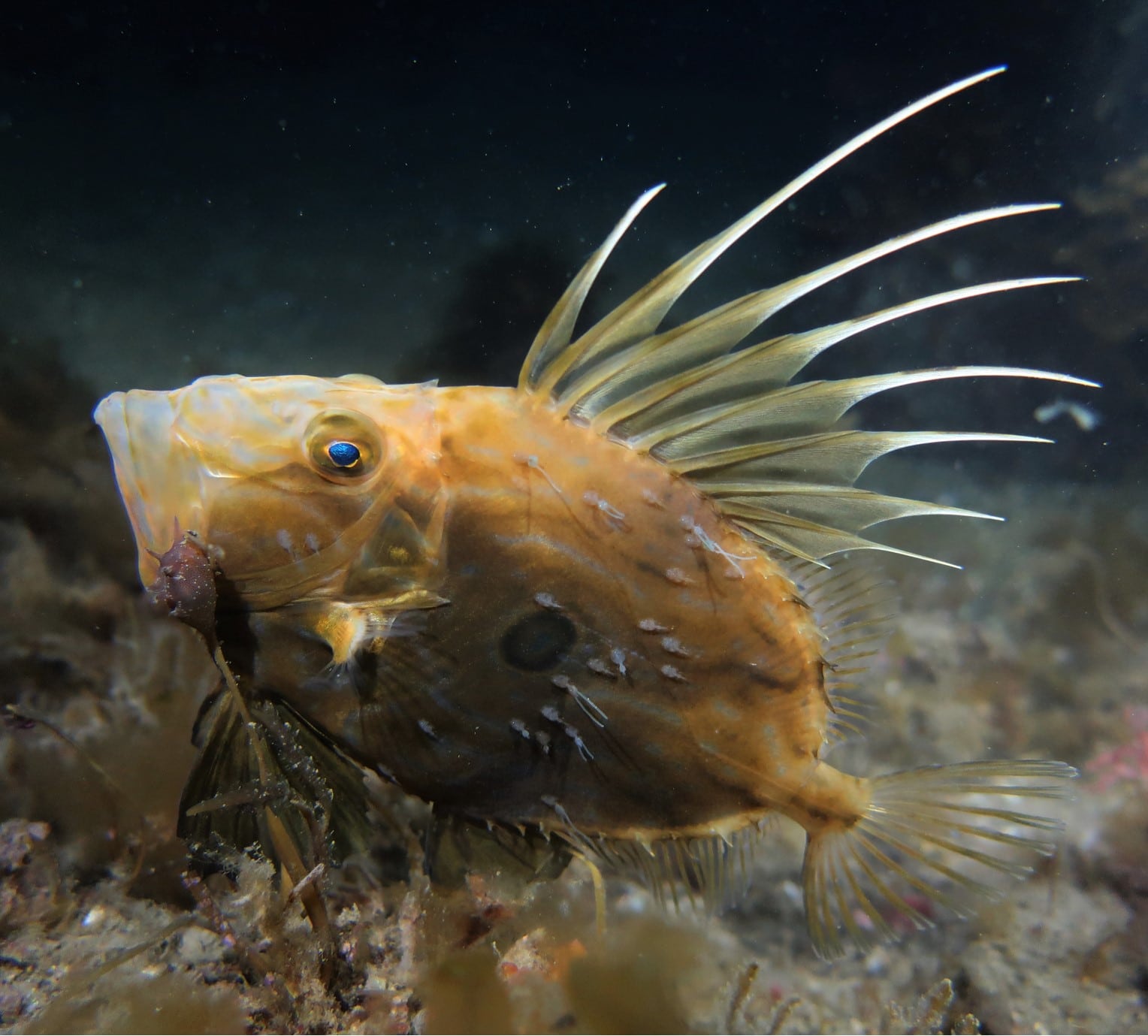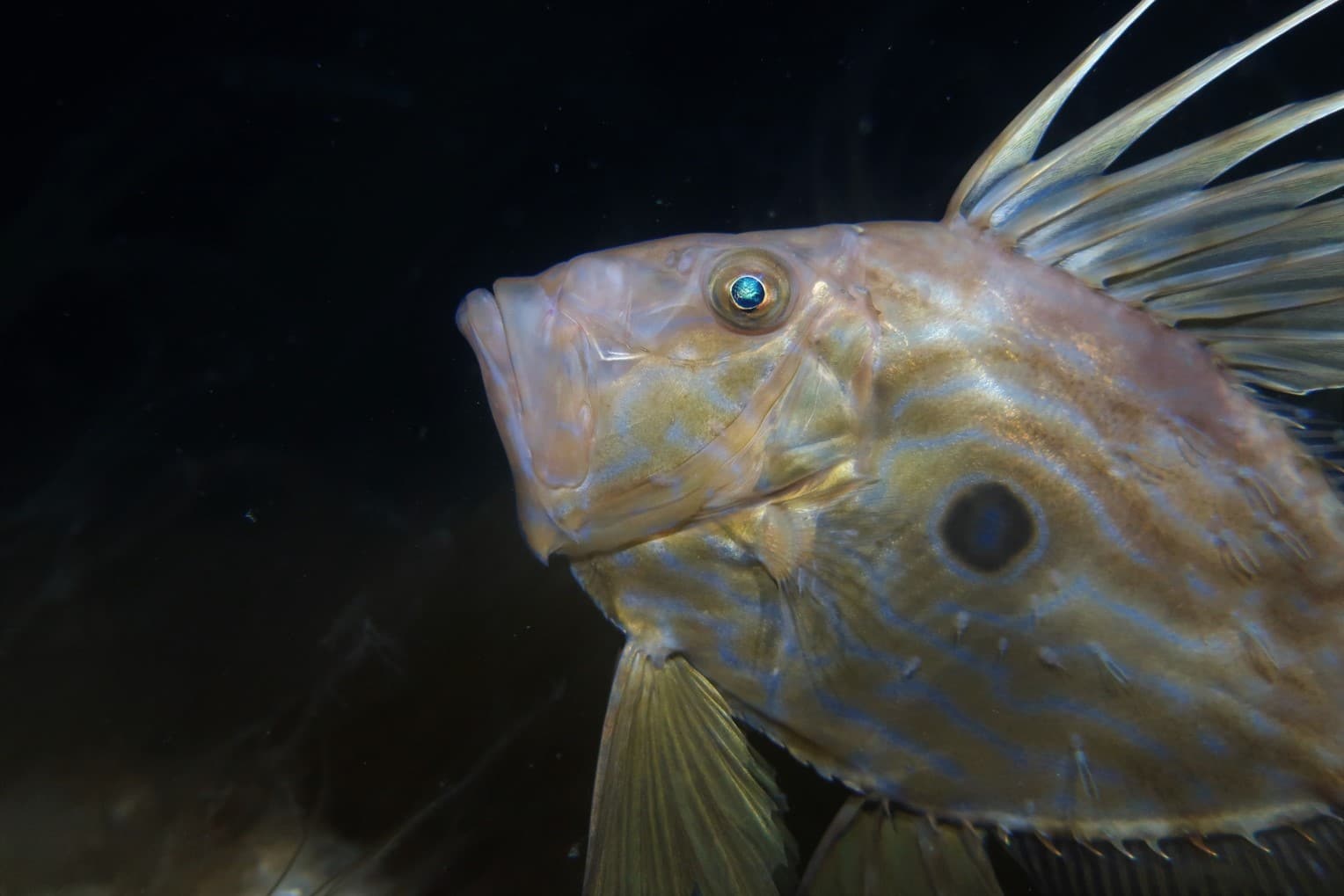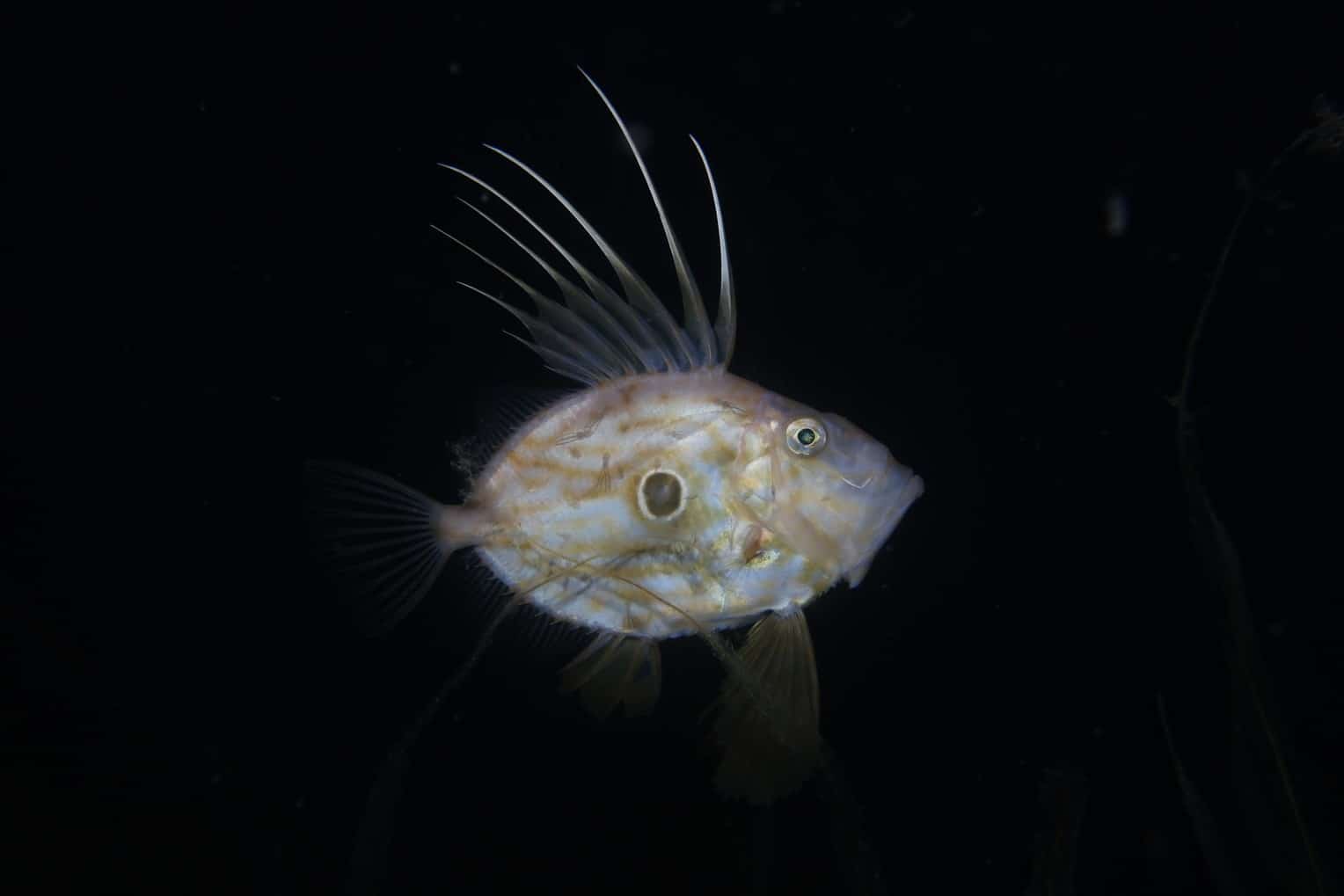Marine Life & Conservation Blogs
Diving with British Marine Life: The John Dory

Part 1 of a new series by our latest blogger Georgie Bull…
A few years ago, I attended a work experience placement at the London Aquarium. During a school session, the staff members gave the children a group of 20 photo cards and asked them to choose which ones they thought showed native species. The cards pictured the likes of corkwing wrasse, orca, basking sharks, cod, whiting, mackerel, and vibrant nudibranchs. Of these, colourful species were seldom selected. At the end of the activity, it was revealed that all the cards showed permanent or seasonal UK residents, which was met with shock from both the pupils and staff.
From this experience, and many more like it, I’ve come to realise just how underappreciated British marine life is.
Over the next six blogs, I will explore just a handful of the charismatic species encountered in the South West of England. I aim to introduce each species, describing my encounters with them before highlighting any relevant literature. There is still so much we don’t know about the species living on our doorstep.
In the build up to my first night dive at Chesil Cove last year, sighting reports circulated that john dory (Zeus faber) were seemingly everywhere. This species had been on my ‘to see’ list for quite some time so any likelihood of seeing one filled me with excitement. Halfway through the dive I noticed a faint, but frantic undulation centred around what looked like a large grumpy dinner plate. It was indeed a john dory. This individual was so full of expression that I found it hard not to fixate myself for the duration of the dive! This was the start of what became a frequent occurrence throughout the season.
Profile
As well as their false eyespot, elongate fins, and disc like body, john dory demonstrate distinctive behaviour in the water. Their movement is relatively slow, though their soft anal and dorsal fins (positioned behind their spined counterparts) move frantically to alter their position in the water. While small, their mouth is capable of rapid extension to draw in prey, and they’ll manoeuvre their bodies into all sorts of strange positions in the water to do so.
Zeus faber are often associated with warm water, but their distribution conflicts this idea, with their Northern range extending as far as Norway!
John dory are categorised as data deficient by the IUCN. The IUCN ranks species based on their population trends, and they are particularly famous for their ‘Red List’ which categorises endangered species. Sometimes insufficient information is available, and the organism is regarded as data deficient. As this is the case for the john dory, questions arise about how their population is coping with its value to the fishing industry.
Literature
It’s true that anglers and divers value john dory, but scientists have been finding out more about the species in recent years. One of their most distinctive features is the false eyespot. These spots are found in a variety of organisms from butterflies to lizards and are thought to divert predator attacks to less essential parts of the body (e.g. the tail) which may offer increased chance of escape. The role of eyespots in nature is understudied, but lab experiments in 2011 and 2013 showed that predators were inclined to attack eyespots spots more so than other areas of the body. This provided evidence in favour of eyespots acting as attack diversions.
On a different note, sound in the marine environment is receiving increased attention recently. Iconic footage captured by the BBC for Blue Planet 2 of reef noise, or hot topics like noise pollution from boat traffic are taking centre stage. But sound in the marine environment is used by individuals to communicate in a variety of different ways. John dory create sounds with sonic muscles that surround their swim bladder. Until 2018, this sound had only been recorded in air. A study recorded the species using baited remote underwater video (BRUV) footage and found that individuals would make the sound when predators were near. This caused predators to flee, suggesting the sound could serve as a territorial defence mechanism. As with all species, there are still many aspects to the life of john dory that we are only just beginning to understand.
References:
- https://www.iucnredlist.org/species/198769/42390771
- https://www.marlin.ac.uk/species/detail/1542
- https://royalsocietypublishing.org/doi/full/10.1098/rspb.2013.1458
- https://link.springer.com/article/10.1007/s00265-011-1173-7
- https://journals.plos.org/plosone/article?id=10.1371/journal.pone.0204647
Hear more from Georgie here: https://georgiebullphotography.home.blog/
Blogs
The Ocean Cleanup Breaks 10,000,000 KG Barrier

The Ocean Cleanup, the global non-profit project, has removed a verified all-time total of ten million kilograms (22 million lbs.) of trash from oceans and rivers around the world – approximately the same weight as the Eiffel Tower.
To complete its mission of ridding the oceans of plastic, The Ocean Cleanup uses a dual strategy: cleaning up the Great Pacific Garbage Patch (GPGP) to remove the plastic already afloat in the oceans, while stopping the flow of plastic from the world’s most polluting rivers.
Through cleaning operations in the GPGP and in rivers in eight countries, the cumulative total of trash removed has now surpassed ten million kilograms. This milestone demonstrates the acceleration of The Ocean Cleanup’s impact, while underlining the astonishing scale of the plastic pollution problem and the need for continued support and action.
While encouraging for the mission, this milestone is only a staging point: millions more tons of plastic still pollute our oceans and The Ocean Cleanup intends to continue learning, improving and innovating to solve this global catastrophe.
This announcement comes as governments from around the world meet to continue negotiations to develop a new legally binding instrument to end plastic pollution at INC4 in Ottawa, Canada. Representatives of The Ocean Cleanup will be in attendance and the organization will be urging decision-makers to collaborate towards a comprehensive and ambitious global treaty which addresses plastic at all stages of its life cycle and in all marine environments worldwide, including in areas beyond national jurisdiction.
It is encouraging to see that the need for remediation is reflected in the various options for potential treaty provisions. It is essential that the final treaty contains clear targets for the remediation of legacy plastic pollution, and reduction of riverine plastic emissions.
Tackling plastic pollution requires innovative and impactful solutions. The treaty should therefore incentivize the innovation ecosystem by fostering innovations that make maximal use of data, technology and scientific knowledge – such as those designed and deployed by The Ocean Cleanup.
‘After many tough years of trial and error, it’s amazing to see our work is starting to pay off – and I am proud of the team who has brought us to this point.’ said Boyan Slat, Founder and CEO of The Ocean Cleanup. ‘While we still have a long way to go, our recent successes fill us with renewed confidence that the oceans can be cleaned.’
The Ocean Cleanup was founded in 2013 and captured its first plastic in 2019, with the first confirmed catch in the GPGP coming soon after the deployment of Interceptor 001 in Jakarta, Indonesia. After surpassing one million kilograms of trash removed in early 2022, the non-profit project has since progressed to the third iteration of its GPGP cleaning solution, known as System 03, and a network of Interceptors currently covering rivers in eight countries, with more deployments set for 2024.
About The Ocean Cleanup
The Ocean Cleanup is an international non-profit organization that develops and scales technologies to rid the world’s oceans of plastic. They aim to achieve this goal through a dual strategy: stemming the inflow via rivers and cleaning up the legacy plastic that has already accumulated in the ocean. For the latter, The Ocean Cleanup develops large-scale systems to efficiently concentrate the plastic for periodic removal. This plastic is tracked and traced through DNV’s chain of custody model to certify claims of origin when recycling it into new products. To curb the tide via rivers, The Ocean Cleanup has developed Interceptor™ solutions to halt and extract riverine plastic before it reaches the ocean. Founded in 2013 by Boyan Slat, The Ocean Cleanup now employs a broadly multi-disciplined team of approximately 140. The foundation is headquartered in Rotterdam, the Netherlands.
For more information, visit: theoceancleanup.com and follow @theoceancleanup on social media.
Marine Life & Conservation Blogs
Creature Feature: Dusky Shark

 In this series, the Shark Trust will be sharing amazing facts about different species of sharks and what you can do to help protect them.
In this series, the Shark Trust will be sharing amazing facts about different species of sharks and what you can do to help protect them.
This month we’re taking a look at the Dusky Shark, a highly migratory species with a particularly slow growth rate and late age at maturity.
Dusky sharks are one of the largest species within the Carcharhinus genus, generally measuring 3 metres total length but able to reach up to 4.2 metres. They are grey to grey-brown on their dorsal side and their fins usually have dusky margins, with the darkest tips on the caudal fin.
Dusky Sharks can often be confused with other species of the Carcharhinus genus, particularly the Galapagos Shark (Carcharhinus galapagensis). They have very similar external morphology, so it can be easier to ID to species level by taking location into account as the two species occupy very different ecological niches – Galapagos Sharks prefer offshore seamounts and islets, whilst duskies prefer continental margins.
Hybridisation:
A 2019 study found that Dusky Sharks are hybridising with Galapagos Sharks on the Eastern Tropical Pacific (Pazmiño et al., 2019). Hybridisation is when an animal breeds with an individual of another species to produce offspring (a hybrid). Hybrids are often infertile, but this study found that the hybrids were able to produce second generation hybrids!
Long distance swimmers:
Dusky sharks are highly mobile species, undertaking long migrations to stay in warm waters throughout the winter. In the Northern Hemisphere, they head towards the poles in the summer and return southwards towards the equator in winter. The longest distance recorded was 2000 nautical miles!
Very slow to mature and reproduce:
The Dusky Shark are both targeted and caught as bycatch globally. We already know that elasmobranchs are inherently slow reproducers which means that they are heavily impacted by overfishing; it takes them so long to recover that they cannot keep up with the rate at which they are being fished. Dusky Sharks are particularly slow to reproduce – females are only ready to start breeding at roughly 20 years old, their gestation periods can last up to 22 months, and they only give birth every two to three years. This makes duskies one of the most vulnerable of all shark species.
The Dusky Shark is now listed on Appendix II of the Convention on the Conservation of Migratory Species (CMS), but further action is required to protect this important species.
Scientific Name: Carcharhinus obscurus
Family: Carcharhinidae
Maximum Size: 420cm (Total Length)
Diet: Bony fishes, cephalopods, can also eat crustaceans, and small sharks, skates and rays
Distribution: Patchy distribution in tropical and warm temperate seas; Atlantic, Indo-Pacific and Mediterranean.
Habitat: Ranges from inshore waters out to the edge of the continental shelf.
Conservation status: Endangered.
For more great shark information and conservation visit the Shark Trust Website
Images: Andy Murch
Diana A. Pazmiño, Lynne van Herderden, Colin A. Simpfendorfer, Claudia Junge, Stephen C. Donnellan, E. Mauricio Hoyos-Padilla, Clinton A.J. Duffy, Charlie Huveneers, Bronwyn M. Gillanders, Paul A. Butcher, Gregory E. Maes. (2019). Introgressive hybridisation between two widespread sharks in the east Pacific region, Molecular Phylogenetics and Evolution 136(119-127), https://doi.org/10.1016/j.ympev.2019.04.013.
-

 News3 months ago
News3 months agoCapturing Critters in Lembeh Underwater Photography Workshop 2024: Event Roundup
-

 Marine Life & Conservation Blogs3 months ago
Marine Life & Conservation Blogs3 months agoCreature Feature: Swell Sharks
-

 Blogs2 months ago
Blogs2 months agoMurex Resorts: Passport to Paradise!
-

 Gear Reviews3 weeks ago
Gear Reviews3 weeks agoGEAR REVIEW – Revolutionising Diving Comfort: The Sharkskin T2 Chillproof Suit
-

 Blogs3 months ago
Blogs3 months agoDiver Discovering Whale Skeletons Beneath Ice Judged World’s Best Underwater Photograph
-

 News2 months ago
News2 months agoPADI Teams Up with Wellness Brand Neuro to Drive Ocean Change and Create a Blue State of Mind
-

 Gear Reviews3 months ago
Gear Reviews3 months agoGear Review: Oceanic+ Dive Housing for iPhone
-

 News3 months ago
News3 months agoWorld’s Best Underwater Photographers Unveil Breathtaking Images at World Shootout 2023






















